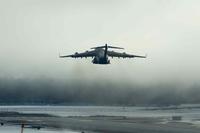U.S. and other NATO allies could have 450 F-35 Joint Strike Fighters stationed in Europe by 2030, the general in charge of U.S. European Command said Wednesday.
Air Force Gen. Tod Wolters, who is also NATO's supreme allied commander for Europe, said during an Atlantic Council discussion that the coalition is continuing to build its fifth-generation fighter capability.
"That's a tremendous capability," Wolters said. "And if I were a potential foe against NATO or Europe, I wouldn't like to hear that."
Read Next: Two-Star Fired After Failures in Deadly AAV Disaster
Wolters' hope for a fleet of 450 F-35s across Europe over the next decade would be a marked increase from current levels.
So far, according to manufacturer Lockheed Martin's website and other public statements, at least 49 F-35 jets have been delivered to allies including the United Kingdom, Norway, Italy, Netherlands and Denmark, with dozens more on the way.
Wolters' comments come as the Air Force is steadily increasing its F-35 presence in Europe. Though F-35s have periodically deployed to Europe since 2017, RAF Lakenheath in England is slated to become the first permanent U.S. F-35 base in Europe this fall.
The 495th Fighter Squadron, which is part of the 48th Fighter Wing at Lakenheath, will take on the nickname "Valkyries" when it becomes the Air Force's first U.K.-based F-35 squadron.
There are currently more than 600 F-35 aircraft operating from nearly 30 locations worldwide, according to Lockheed Martin.
Wolters also said he's excited to see what is in the works for the Air Force's planned future Next Generation Air Dominance program, or NGAD, which defies the traditional categorization of a single platform, featuring a network potentially including an advanced fighter aircraft alongside sensors, weapons or drones. He added that the German, British and French also have initiatives in the works on a potential sixth-generation fighter which couples with autonomous weapons or drones.
-- Oriana Pawlyk contributed to this report.
-- Stephen Losey can be reached at stephen.losey@military.com. Follow him on Twitter @StephenLosey.
Related: Air Force's First Overseas F-35 Fighter Squadron Gets Crowdsourced New Name












